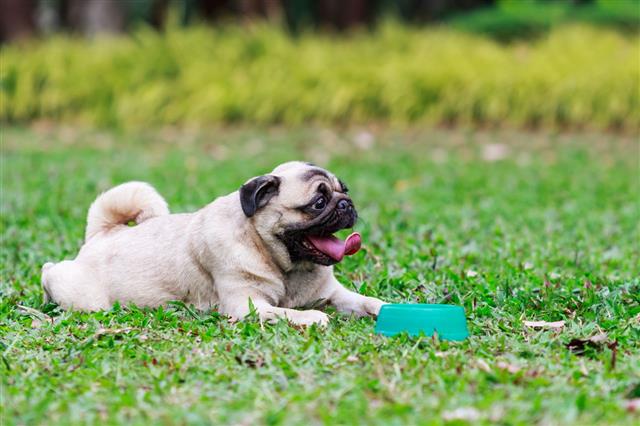
Use of coconut oil, turmeric, and herbs like witch hazel that are known for their antimicrobial effects may work in curing sebaceous cysts in dogs. Read the following DogAppy article to know more about the natural ways to treat these skin eruptions in dogs.
Caution!
Dogs have the habit of chewing the sebaceous cyst that has erupted on their skin. In such circumstances, fitting a cone or Elizabethan collar is advised so they will not make their situation worse.
Sebaceous cysts are small bumps protruding from within the skin. They have been linked to a disorder of the sebaceous glands. The sebaceous gland is an oil-producing gland that lies underneath the skin. This oily substance (sebum) prevents the skin from becoming dry.
These glands are located in the hair follicles, pouches that contain the hair root. However, if these sebaceous cysts get blocked due to damage to the hair follicles, the oily secretion begins to accumulate below the skin. Hence, a formation of small lumps commonly referred to as sebaceous cysts.
Sebaceous cysts are harmless and treatment is not necessary unless they become infected. In the absence of any infection, these bumps appear white and do not cause any pain.
Infected Cysts
When the sebaceous cyst gets infected, pus forms, it appears red, inflamed, and enlarged. These infected cysts are painful and may hurt your pet when touched. Often infected cysts get damaged and release pus and blood.
Treatment
Following are some home remedies to treat these infected sebaceous cysts in dogs:
Warm Compress
Applying a warm compress regularly can be helpful to drain the cyst naturally. A warm compress dilates the blood vessels, thereby increasing blood circulation in the affected area. The increased blood flow not only delivers nutrients but also drains the inflammatory components that are causing swelling. Apply it 3-4 times for 10-15 minutes daily to reduce the swelling. With regular application, the cyst may dissolve naturally without causing any scabbing, in turn reducing the chances of scar formation.
Castor Oil
Thanks to its antimicrobial properties, castor oil can work wonders to clear these unwanted growths. The castor oil displays antibacterial, antiviral as well as antifungal activity. Hence, its topical application can be helpful to reduce inflammation and the itchy sensation associated with sebaceous cysts. Gently rubbing a few drops of castor oil over the affected area, a couple of times daily may eventually help the dog get rid of these skin eruptions.
Turmeric
Turmeric known for its infection-fighting ability may also contribute to healing sebaceous cysts in dogs. Curcumin, the active ingredient in turmeric is anti-inflammatory and displays antiseptic properties. So its external application will reduce the swelling as well as treat the infection.
Turmeric when given internally can also contribute to treating cysts effectively. Mix a small amount of turmeric (less than a teaspoon) in your dog’s food daily to clear these skin eruptions.
Coconut Oil
Among the wealth of benefits coconut oil offers, this one might be the least popular. The antimicrobial effects of virgin coconut oil can act as a great healing aid in the treatment of sebaceous cysts. It can help to combat infections caused by fungus, bacteria, and viruses. In fact, lauric acid, predominantly present in coconut oil is said to provide immune-boosting benefits. Applying a small amount of coconut oil on the infected area can also help deal with these skin problems effectively.
Witch Hazel
Witch hazel celebrated for its astringent properties can also help in curing sebaceous cysts in dogs. These astringent herbs contain tannins which draw out excess oil and tighten the skin pores, in turn decreasing the size of the cyst. Using a cotton ball, apply the extract of witch hazel (available in the form of gel and cream) on your pet’s infected area. Follow this skincare routine daily and you will soon notice your dog’s cyst fading away.
Diet
One of the best ways to treat and keep these lumps from forming is by ensuring that your pet is getting healthy foods. A healthy diet can go a long way in keeping your dog’s skin and coat in top condition. Feeding high quality protein foods that are good sources of omega-3s and omega-6s can help improve the skin and coat. These essential fatty acids are also found aplenty in fish oil and sunflower oil. You may mix 1 teaspoon of the oil into your dog’s meal.
Regularly brushing your dog’s coat is equally important as it prevents sebum from accumulating below the follicle, which often leads to the development of cysts. On the whole, sebaceous cysts that are not bothering your pet are not a cause for concern and treatment may be unwarranted. However, in case you find them infected, seek veterinary advice and discuss the aforementioned home remedies at length before you go ahead.
Disclaimer: The information provided in this article is solely for educating the reader. It is not intended to be a substitute for the advice of a veterinarian.






